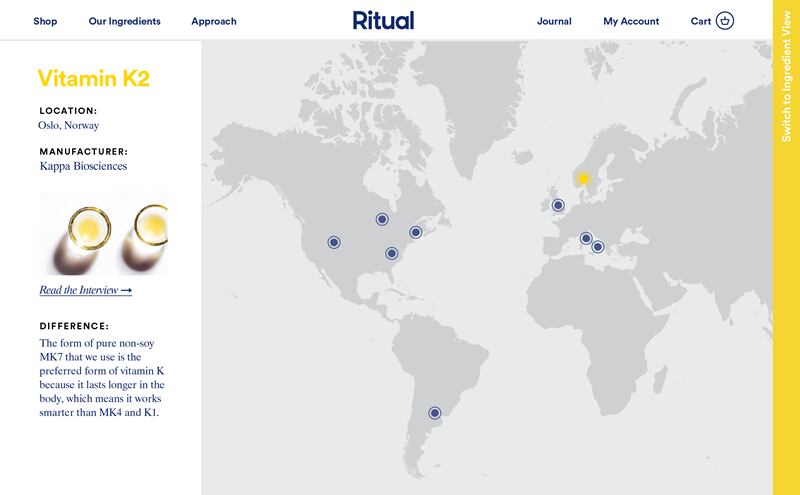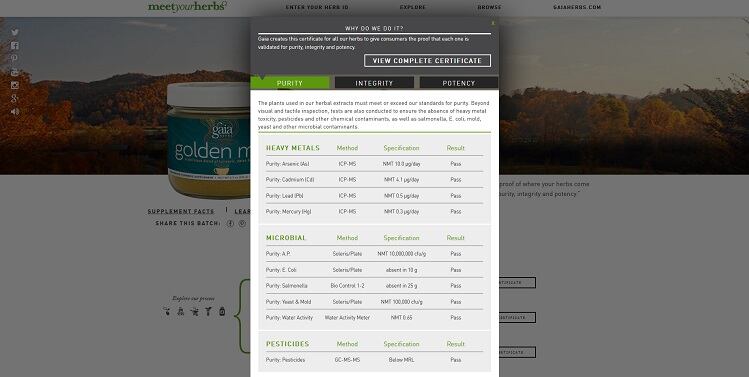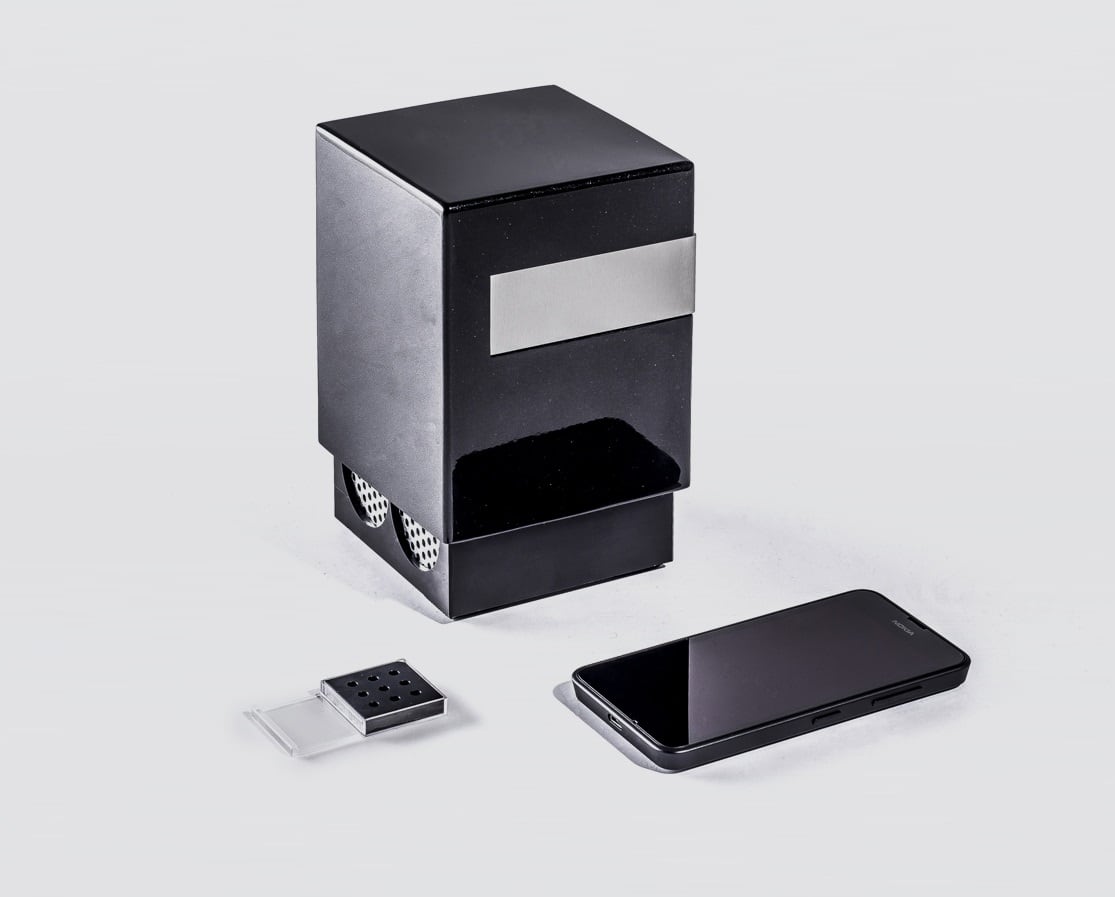
It’s hard to tell what a supplement contains when it’s dried and powdered or compressed into a pill. Bad press around the industry doesn’t help with consumer trust either.
The ‘you-don’t-really-know-what’s-in-them’ argument gained mainstream attention amid the highly publicized investigation led by the now-disgraced New York Attorney General Eric Schneiderman in 2015. Schneiderman sent letters to national retailers like GNC and Walgreens asking them to stop selling some herbal supplements after DNA tests found 79% didn’t contain the labeled substance.
It’s hard to measure the impact the investigation had on how consumers trust the industry, but it has certainly set the tone surrounding transparency. A good gauge for this is how finished product brands are trying to communicate transparency to consumers today.
Ritual profiles its ingredient suppliers
In late 2016, an industry newcomer called Ritual tackled transparency literally and figuratively. Its transparent multivitamin capsules, reminiscent of crystal vials of sparkly white beads, contain nine ingredients: Vitamin K2, vitamin D3, vitamin B12, boron, iron, vitamin E, magnesium, folate, and omega-3.
For each of these ingredients, the company profiles its suppliers, with tables summarizing the latest published studies and an interview with personnel from the supplier companies (for example, a Q&A with Doug Brown, senior director and product manager at DSM, which supplied the omega-3).
“Here’s a $30 billion plus industry, and yet there are so many of us who have no idea what vitamins to take [and] what was in vitamins we were taking every day, it just seemed like an interesting opportunity to build a brand,” Katerina Schneider, Ritual’s CEO and founder, told us in an interview in 2017.
Batch ID numbers
Another approach to transparency is legacy brand Gaia Herbs’ platform MeetYourHerbs.com, which was introduced in April 2015.
Using the platform, consumers can look up an ‘Herb ID’ number that is printed on each product packaging. After putting in a number, visitors are brought to the product’s profile page with a breakdown of each ingredient’s science, geographic origin, harvest method, and identity validation method.
It also includes analysis of heavy metal, microbial, and pesticide residue levels of each ingredient.
“All of this testing ensures that any product labeled with the Gaia Herbs name is one that people can trust and feel good about putting in their body,” said Elena Lécué, EVP of sales and marketing at Gaia Herbs.


“The MeetYourHerbs platform has been accessed more than 310,000 times since its launch and trace pages [the landing page after entering an Herb ID number] have been viewed 54,000 times during this period," she added.
According to Lécué, the platform is the world’s first herb traceability program, developed because the company believes “with knowledge comes empowerment and the ability to make healthier choices.”
More than half of all traffic to the platform comes from Gaia Herbs’ main website, while the other 20% comes from consumers entering an Herb ID after reading it on their product label.
“During the last year, we’ve seen 5% growth in traffic to MeetYourHerbs.com trace pages. Although we do not have any specific insight into the increase, we believe it is due to the increased attention that we have given to this program in our advertising materials as well as increasing consumer interest in sourcing and transparency,” Lécué said.
What information are consumers looking for?
Profiling suppliers the way Ritual does was a transparency method that California-based Nutri-Rich tried when it changed ownership and rebranded in 2015.
Today, the company no longer includes profiles of its ingredient manufacturers. “Consumers indicated through surveys and feedback that they were more interested in their specific products, rather than the specific suppliers,” Lisa Wang, brand manager at Nutri-Rich, told us.
In place of the supplier profiles is the Batch Tracer. Similar to Gaia Herbs’ MeetYourHerbs.com, each product has a batch number printed on its packaging, which consumers can look-up online to get information of production date and certificate of analysis results (with heavy metal levels testing down to the decimal point).
“We will incorporate some of the more notable supplier information such as our omega-3 suppliers on product pages in future website revisions, to add flavor and context to the product story,” she added. “Ultimately, the crux of our transparency goals are well addressed in our new tools.”
More consumers will be interested in tracing herb info back to the field
Cosimo Palumbo, marketing director for Italy-based ingredient supplier Indena SpA, thinks that today’s consumer will increasingly rely on mobile devices to scrutinize a product’s supply chain—if not while online shopping, then on the spot at the store aisle.
“Mobile technologies offer easy access to mobile health apps, that on top of helping tailoring your health program, sooner than later will also integrate information on the product supply chain back to the field (in case of botanicals) for complete traceability,” he said.

Indena SpA provides plant-derived ingredients to the dietary supplements, food, personal care, and pharmaceutical industries. The diversity of industries, and diversity of how they’re regulated, means the company must be prepared to abide by strictest regulations.
“Because of our pharmaceutical heritage, not only do we use genomic tests for some [application program interfaces] but we were also applying this technology in the dietary supplement space to potentially problematic species years before Schneiderman came along,” Palumbo said.
Doing the DNA testing for finished product makers
Today, Indena SpA helps its finished product customers communicate transparency by integrating DNA sequencing into its quality system.
"We share on request the results with our customers as additional test on top of the numerous QC evidence we routinely provide," Palumbo said. "It is up to our customers putting together a B2C solution that enables consumers to get access to this data. We certainly welcome any solution that promotes transparency."
The ingredient supplier partnered with British company Hyris Ltd, patent owner of bCUBE, a device capable of carrying out DNA finger print analysis on plant samples in roughly one hour. Data is then sent to a cloud, helping future analyses go even faster.
Last fall, Indena SpA, Hyris, and the NHP Research Alliance signed a cooperation agreement for the joint development of DNA authentication test kits for botanicals and related natural health products.
Nevertheless, DNA authentication shouldn’t be the be-all and end-all, Palumbo added “Although DNA-based identification technologies are contributing decisively to the authentication of botanicals, they are not THE reference methods: they very well complement the botanical and chemotaxonomic and metabolomics analytical methods,” she said.
“Accordingly, they have to be part of a complete quality texting toolbox, which constitutes a reliable authentication platform.”
